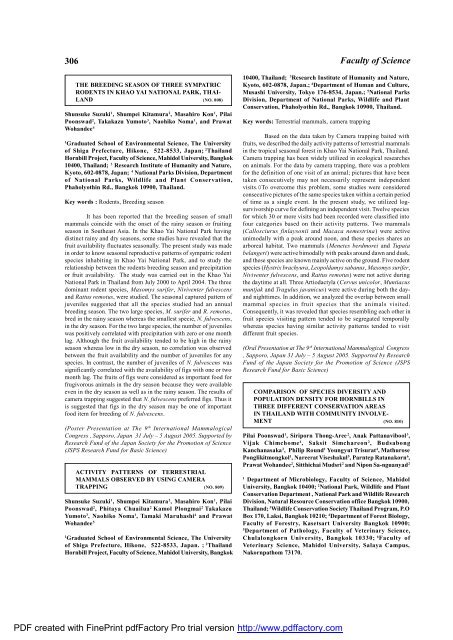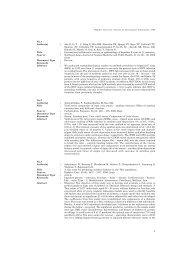Faculty of Science - Mahidol University
Faculty of Science - Mahidol University
Faculty of Science - Mahidol University
You also want an ePaper? Increase the reach of your titles
YUMPU automatically turns print PDFs into web optimized ePapers that Google loves.
306<br />
THE BREEDING SEASON OF THREE SYMPATRIC<br />
RODENTS IN KHAO YAI NATIONAL PARK, THAI-<br />
LAND (NO. 808)<br />
Shunsuke Suzuki 1 , Shumpei Kitamura 2 , Masahiro Kon 1 , Pilai<br />
Poonswad 2 , Takakazu Yumoto 3 , Naohiko Noma 1 , and Prawat<br />
Wohandee 4<br />
1 Graduated School <strong>of</strong> Environmental <strong>Science</strong>, The <strong>University</strong><br />
<strong>of</strong> Shiga Prefecture, Hikone, 522-8533, Japan; 2 Thailand<br />
Hornbill Project, <strong>Faculty</strong> <strong>of</strong> <strong>Science</strong>, <strong>Mahidol</strong> <strong>University</strong>, Bangkok<br />
10400, Thailand; 3 Research Institute <strong>of</strong> Humanity and Nature,<br />
Kyoto, 602-0878, Japan; 4 National Parks Division, Department<br />
<strong>of</strong> National Parks, Wildlife and Plant Conservation,<br />
Phaholyothin Rd., Bangkok 10900, Thailand.<br />
Key words : Rodents, Breeding season<br />
It has been reported that the breeding season <strong>of</strong> small<br />
mammals coincide with the onset <strong>of</strong> the rainy season or fruiting<br />
season in Southeast Asia. In the Khao Yai National Park having<br />
distinct rainy and dry seasons, some studies have revealed that the<br />
fruit availability fluctuates seasonally. The present study was made<br />
in order to know seasonal reproductive patterns <strong>of</strong> sympatric rodent<br />
species inhabiting in Khao Yai National Park, and to study the<br />
relationship between the rodents breeding season and precipitation<br />
or fruit availability. The study was carried out in the Khao Yai<br />
National Park in Thailand from July 2000 to April 2004. The three<br />
dominant rodent species, Maxomys surifer, Niviventer fulvescens<br />
and Rattus remotus, were studied. The seasonal captured pattern <strong>of</strong><br />
juveniles suggested that all the species studied had an annual<br />
breeding season. The two large species, M. surifer and R. remotus,<br />
bred in the rainy season whereas the smallest specie, N. fulvescens,<br />
in the dry season. For the two large species, the number <strong>of</strong> juveniles<br />
was positively correlated with precipitation with zero or one month<br />
lag. Although the fruit availability tended to be high in the rainy<br />
season whereas low in the dry season, no correlation was observed<br />
between the fruit availability and the number <strong>of</strong> juveniles for any<br />
species. In contrast, the number <strong>of</strong> juveniles <strong>of</strong> N. fulvescens was<br />
significantly correlated with the availability <strong>of</strong> figs with one or two<br />
month lag. The fruits <strong>of</strong> figs were considered as important food for<br />
frugivorous animals in the dry season because they were available<br />
even in the dry season as well as in the rainy season. The results <strong>of</strong><br />
camera trapping suggested that N. fulvescens preferred figs. Thus it<br />
is suggested that figs in the dry season may be one <strong>of</strong> important<br />
food item for breeding <strong>of</strong> N. fulvescens.<br />
(Poster Presentation at The 9 th International Mammalogical<br />
Congress , Sapporo, Japan 31 July – 5 August 2005. Supported by<br />
Research Fund <strong>of</strong> the Japan Society for the Promotion <strong>of</strong> <strong>Science</strong><br />
(JSPS Research Fund for Basic <strong>Science</strong>)<br />
ACTIVITY PATTERNS OF TERRESTRIAL<br />
MAMMALS OBSERVED BY USING CAMERA<br />
TRAPPING (NO. 809)<br />
Shunsuke Suzuki 1 , Shumpei Kitamura 2 , Masahiro Kon 1 , Pilai<br />
Poonswad 2 , Phitaya Chuailua 2 Kamol Plongmai 2 Takakazu<br />
Yumoto 3 , Naohiko Noma 1 , Tamaki Maruhashi 4 and Prawat<br />
Wohandee 5<br />
1 Graduated School <strong>of</strong> Environmental <strong>Science</strong>, The <strong>University</strong><br />
<strong>of</strong> Shiga Prefecture, Hikone, 522-8533, Japan. ; 2 Thailand<br />
Hornbill Project, <strong>Faculty</strong> <strong>of</strong> <strong>Science</strong>, <strong>Mahidol</strong> <strong>University</strong>, Bangkok<br />
10400, Thailand; 3 Research Institute <strong>of</strong> Humanity and Nature,<br />
Kyoto, 602-0878, Japan.; 4 Department <strong>of</strong> Human and Culture,<br />
Musashi <strong>University</strong>, Tokyo 176-8534, Japan.; 5 National Parks<br />
Division, Department <strong>of</strong> National Parks, Wildlife and Plant<br />
Conservation, Phaholyothin Rd., Bangkok 10900, Thailand.<br />
Key words: Terrestrial mammals, camera trapping<br />
<strong>Faculty</strong> <strong>of</strong> <strong>Science</strong><br />
Based on the data taken by Camera trapping baited with<br />
fruits, we described the daily activity patterns <strong>of</strong> terrestrial mammals<br />
in the tropical seasonal forest in Khao Yai National Park, Thailand.<br />
Camera trapping has been widely utilized in ecological researches<br />
on animals. For the data by camera trapping, there was a problem<br />
for the definition <strong>of</strong> one visit <strong>of</strong> an animal; pictures that have been<br />
taken consecutively may not necessarily represent independent<br />
visits.0To overcome this problem, some studies were considered<br />
consecutive pictures <strong>of</strong> the same species taken within a certain period<br />
<strong>of</strong> time as a single event. In the present study, we utilized logsurvivorship<br />
curve for defining an independent visit. Twelve species<br />
for which 30 or more visits had been recorded were classified into<br />
four categories based on their activity patterns. Two mammals<br />
(Callosciurus finlaysonii and Macaca nemestrina) were active<br />
unimodally with a peak around noon, and these species shares an<br />
arboreal habitat. Two mammals (Menetes berdmorei and Tupaia<br />
belangeri) were active bimodally with peaks around dawn and dusk,<br />
and these species are known mainly active on the ground. Five rodent<br />
species (Hystrix brachyura, Leopoldamys sabanus, Maxomys surifer,<br />
Niviventer fulvescens, and Rattus remotus) were not active during<br />
the daytime at all. Three Artiodactyla (Cervus unicolor, Muntiacus<br />
muntjak and Tragulus javanicus) were active during both the dayand<br />
nighttimes. In addition, we analyzed the overlap between small<br />
mammal species in fruit species that the animals visited.<br />
Consequently, it was revealed that species resembling each other in<br />
fruit species visiting pattern tended to be segregated temporally<br />
whereas species having similar activity patterns tended to visit<br />
different fruit species.<br />
(Oral Presentation at The 9 th International Mammalogical Congress<br />
, Sapporo, Japan 31 July – 5 August 2005. Supported by Research<br />
Fund <strong>of</strong> the Japan Society for the Promotion <strong>of</strong> <strong>Science</strong> (JSPS<br />
Research Fund for Basic <strong>Science</strong>)<br />
COMPARISON OF SPECIES DIVERSITY AND<br />
POPULATION DENSITY FOR HORNBILLS IN<br />
THREE DIFFERENT CONSERVATION AREAS<br />
IN THAILAND WITH COMMUNITY INVOLVE-<br />
MENT (NO. 810)<br />
Pilai Poonswad 1 , Siriporn Thong-Aree 2 , Anak Pattanavibool 3 ,<br />
Vijak Chimchome 4 , Saksit Simchareon 2 , Budsabong<br />
Kanchanasaka 2 , Philip Round 1 Youngyut Trisurat 4 , Mathurose<br />
Ponglikitmongkol 1 , Nareerat Viseshakul 5 , Parntep Ratanakorn 6 ,<br />
Prawat Wohandee 2 , Sitthichai Mudsri 2 and Nipon Sa-nguanyad 2<br />
1 Department <strong>of</strong> Microbiology, <strong>Faculty</strong> <strong>of</strong> <strong>Science</strong>, <strong>Mahidol</strong><br />
<strong>University</strong>, Bangkok 10400; 2 National Park, Wildlife and Plant<br />
Conservation Department , National Park and Wildlife Research<br />
Division, Natural Resource Conservation <strong>of</strong>fice Bangkok 10900,<br />
Thailand; 3 Wildlife Conservation Society Thailand Program, P.O<br />
Box 170, Laksi, Bangkok 10210; 4 Department <strong>of</strong> Forest Biology,<br />
<strong>Faculty</strong> <strong>of</strong> Forestry, Kasetsart <strong>University</strong> Bangkok 10900;<br />
5 Department <strong>of</strong> Pathology, <strong>Faculty</strong> <strong>of</strong> Veterinary <strong>Science</strong>,<br />
Chulalongkorn <strong>University</strong>, Bangkok 10330; 6 <strong>Faculty</strong> <strong>of</strong><br />
Veterinary <strong>Science</strong>, <strong>Mahidol</strong> <strong>University</strong>, Salaya Campus,<br />
Nakornpathom 73170.<br />
PDF created with FinePrint pdfFactory Pro trial version http://www.pdffactory.com
















